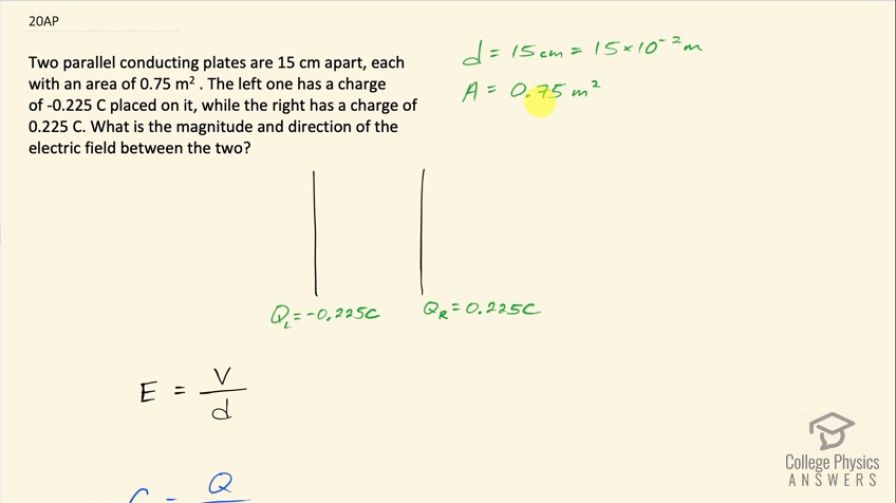Question
Two parallel conducting plates are 15 cm apart, each with an area of . The left one has a charge of -0.225 C placed on it, while the right has a charge of 0.225 C. What is the magnitude and direction of the electric field between the two?
Final Answer
Solution video
OpenStax College Physics for AP® Courses, Chapter 19, Problem 20 (Test Prep for AP® Courses)

vote with a rating of
votes with an average rating of
.
Calculator Screenshots
Video Transcript
This is College Physics Answers with Shaun Dychko. Two parallel conducting plates are 15 centimeters apart and they each have an area of 0.75 square meters and negative 0.225 coulombs is placed on the left plate and then the right plate gets positive 0.225 coulombs and it's going to ask what the magnitude and direction of the electric field between the two plates is? Well, we can tell already that the field is going to be directed towards the left because it's going to go from the positive plate towards the negative plate; electric field points in the direction of a force that would be applied on a hypothetical positive test charge if you placed it somewhere. So that test charge would be repelled from the positive plate and it would go towards the negative plate. Okay! The electric field between the plates is going to be the voltage between them divided by the separation between the plates and we need to create expressions to substitute for these things since we don't know what the voltage is. So we know the capacitance of the plates is going to be the charge that each of them has and the charges are of equal magnitude here and that's what this Q represents— what is the magnitude of the charge that each of the plate has— and divide that by the voltage. So we can rearrange this to solve for V by multiplying both sides by V over C and then we have a thing we can substitute in for V in our expression for electric field so we can replace V with Q over C. So this is Q over—separation—d times capacitance. Then we have another expression for the capacitance of a parallel plate capacitor and it is the permittivity of free space times the area of each plate divided by the separation between them so we can substitute that in place of C. So this is a single fraction ε naughtA over d and we are going to multiply by its reciprocal instead of dividing a fraction by a fraction so we are going to multiply by d over ε naughtA. The d's cancel and our electric field then is the charge divided by permittivity of free space times the area of each plate. So that's 0.225 coulombs divided by 8.85 times 10 to the minus 12 farads per meter times 0.75 square meters and that is 3.4 times 10 to the 10 newtons per coulomb towards the left.
